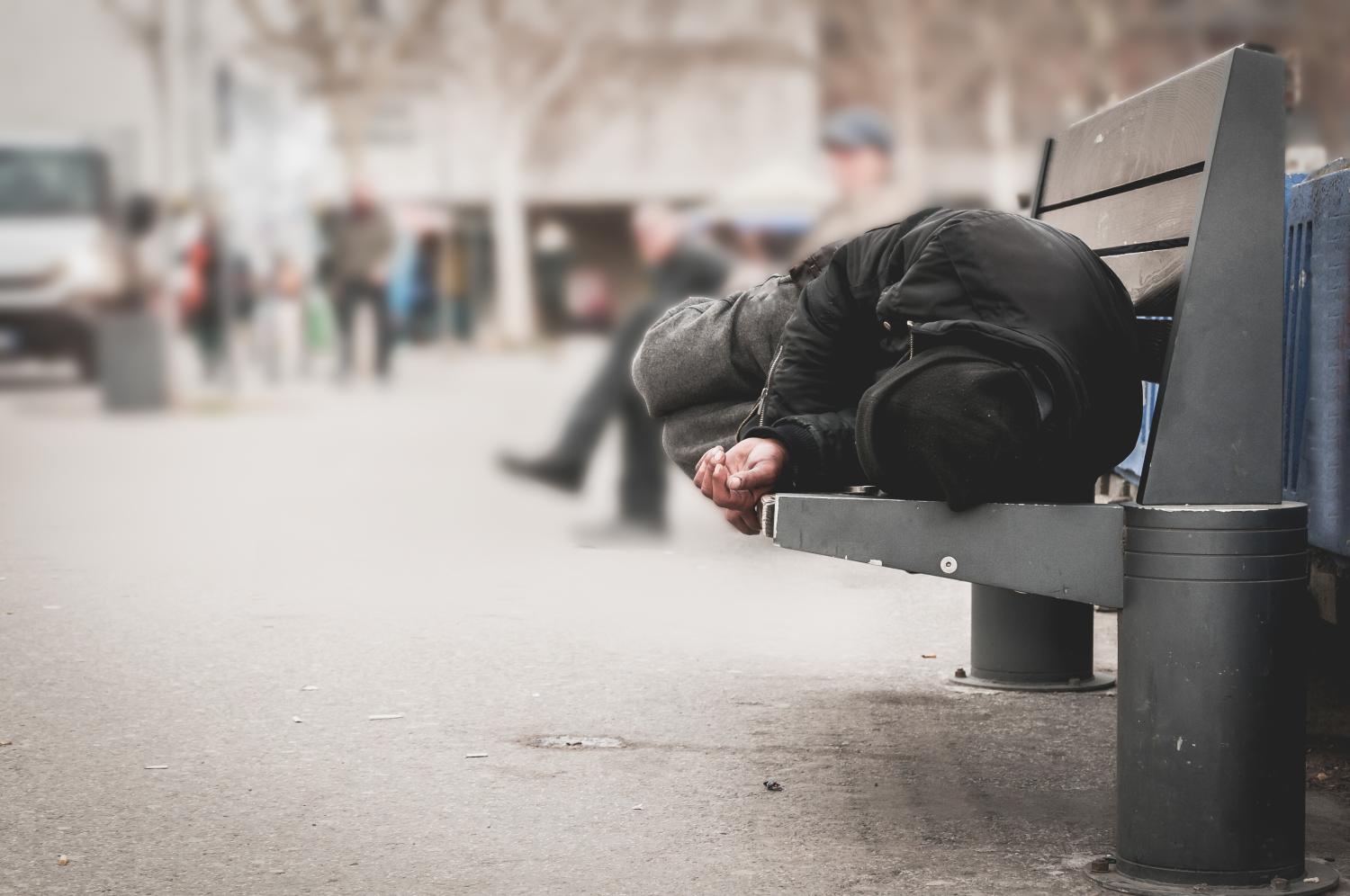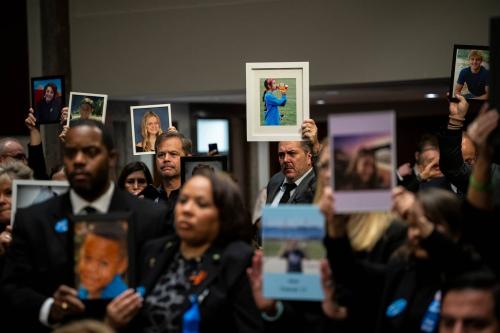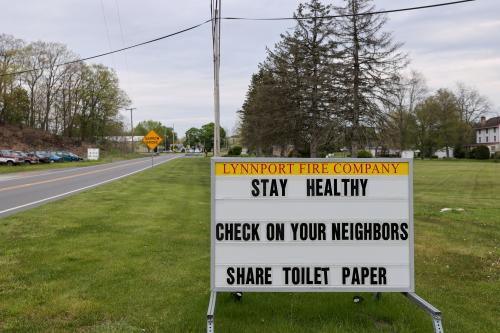Exposure to poverty is deeply intertwined with the deterioration of emotional health. This linkage is often exacerbated by a lack of coordinated social support for individuals and families. To appreciate this connection and how efforts in some communities suggest ways to address it, consider three public health issues and their impact on mental health: homelessness, food insecurity, and hygiene poverty (i.e., a lack of resources to maintain personal hygiene).
Homelessness
There is a close connection between homelessness and mental health. Since the start of the COVID-19 pandemic, homelessness and associated behavioral health issues have increased. While there are widely differing estimates of the prevalence of mental disorders among individuals experiencing homelessness, a review of the research by the Substance Abuse and Mental Health Services Administration (SAMHSA) suggests that between 20% and 50% have serious mental illness. Research suggests, moreover, that the experience of being homeless often intensifies the condition of individuals with poor mental health, with factors such as increased stress aggravating previous mental illness through heightened anxiety, fear, substance use, etc.
Some believe that the best course of action for those experiencing homelessness and mental illness is to provide treatment and services first so that homeless individuals are stabilized and “housing ready,” and only then can live successfully in permanent housing. Under this approach, placement in housing would follow initial treatment. However, many jurisdictions now use a Housing First model. In this approach, an individual is placed into permanent supported housing as the first step, followed swiftly with treatment and social service supports to start addressing the individual’s physical and mental health, education, employment, and substance use issues. Studies suggest this is an improvement on “treatment first” approaches.
How communities are addressing the challenge
- Philadelphia, Pennsylvania – Pathways to Housing: Pathways to Housing works with individuals experiencing homelessness to provide housing without treatment preconditions and, once participants are housed, goes on immediately to address underlying issues involving mental health, substance use, medical care, and education. After arranging housing, Pathways manages an integrated care clinic to ensure that “participants have access to a low-barrier, person-centered approach that emphasizes recovery, wellness, trauma-informed care, and the integration of physical and behavioral health care.”
- Denver, Colorado – Colorado Coalition for the Homeless: The Colorado Coalition for the Homeless (CCH) operates twenty permanent supportive housing and affordable housing properties and administers housing vouchers nearly 1,300 households in the Denver area. Like Pathways, the Coalition takes steps to ensure that, once housed, residents immediately receive the physical and behavioral health services they need to be able to achieve stability. CCH provides integrated medical and behavioral health care, substance use treatment, dental, vision, and pharmacy services through an on-site Federally Qualified Health Center.
- New York City, New York – Breaking Ground: Breaking Ground provides permanent supportive housing for individuals who have experienced chronic homelessness in New York City. Housing is co-located with wraparound services such as on-site medical care, psychiatric care, substance use referrals, and skills-building/employment programs. In addition to a focus on housing, Breaking Ground provides New Yorkers who remain unhoused with Street to Home services, which include 24/7 engagement and outdoor counseling and connections with available medical and social supports. Programs like this are likely to be particularly important in the context of New York City’s new plan to involuntarily hospitalize unhoused individuals with mental health conditions despite a chronic psychiatric bed shortage in city hospitals.
What else could be done to help?
- Expand Housing First models to encompass more communities, including those in rural areas. As illustrated in the examples above, Housing First programs show that providing stable housing can improve the efficacy of psychiatric and substance abuse treatment as well as aid in connecting individuals to social services. A 2018 study on the effects of housing stability service use among homeless adults with mental illness found that participants who achieved housing stability had decreased use of inpatient psychiatric hospitals and emergency departments. Currently the severe shortage of affordable housing makes it very difficult in many jurisdictions to provide immediate housing for homeless individuals. Moreover, although the federal Department of Housing and Urban Development distributes emergency Section 8 housing vouchers to jurisdictions for unhoused individuals and people attempting to flee domestic violence, it is common for people to wait years for voucher assistance. Achieving the goal of stable housing for people with mental health conditions will therefore require ramped-up investment in housing as well as health and social service supports for residents.
- Utilize mobile crisis intervention teams to address social and behavioral health needs of individuals experiencing homelessness that are at risk for a mental health crisis. Breakthroughs in mental health services are often the result of multi-agency partnerships. One such breakthrough has been the development of local crisis intervention teams, which use a co-response model between law enforcement, emergency medical services, and mental health providers. In a previous publication, we highlighted several successful programs using this model. Since the full launch of the 988 suicide and crisis lifeline in June of 2022, many jurisdictions are working to deploy crisis intervention teams for behavioral health emergencies in a way that is most beneficial to those in need, including those experiencing homelessness. Moreover, states can now receive an enhanced federal medical assistance percentage (FMAP) for mental health crisis systems.
- Improve the coordination and continuation of services for people experiencing homelessness. Departments at all levels of government often fail people with housing and mental health problems because of administrative obstacles and budget silos. Fortunately, there have been some steps to tackle these challenges. California, Arkansas and other states, for instance, have received federal Medicaid 1115 Waivers that allow them to better coordinate housing, health care, and other services for vulnerable populations. In February 2023, Congresswoman Madeleine Dean reintroduced legislation through The Homelessness and Behavioral Health Care Coordination Act to the House of Representatives, which would authorize a Housing and Urban Development (HUD) grant to enable state/local/tribal entities to coordinate care for individuals simultaneously experiencing homelessness, behavioral health, and substance use disorders.
Food Insecurity
The U.S. Department of Agriculture (USDA) estimates that in 2021 over 34 million people—including 9 million children—were living in households that did not have enough to eat. Many of these families do not qualify for federal nutrition programs such as Supplemental Nutrition Assistance (SNAP) or the National School Lunch Program (NSLP) and are dependent on food banks or community donations. A national study found that food insecurity was associated with a 257% higher risk of anxiety and a 253% higher risk of depression among low-income families. Mothers and children appear to be at an especially high risk of mental health distress associated with food insecurity. For instance, food insecurity can exacerbate postpartum depression, and food insecurity has been found to be associated with increased behavioral and emotional dysregulation during infancy and adolescence. Food insecurity has also been associated with maternal depression and increased developmental risk in children such as decreased psychosocial function, elevated aggression, anxiety, depression, hyperactivity, and difficulties interacting with peers. In another study conducted to analyze the relationship between food insecurity and poor mental health, researchers discovered that food insecurity correlates to depression, anxiety, shame, and acute psychological stress.
What is being done in some communities?
- Maryland – Frustrated by the lack of food access and overburdened charity models, the Black Church Food Security Network (BCFSN) created a self-sustaining food system at Pleasant Hope Baptist Church in Baltimore, MD. Using the community garden at the church, the organization created a pipeline for fresh food from the garden directly to community members experiencing food insecurity. The organization has grown into a partnership of Black churches across the country to provide health-related, environmental, and economic benefits to those most vulnerable.
- Connecticut – Recognizing that the quality of a diet can serve as either a risk factor or protective factor to mental health, Mental Health Connecticut (MHC) partnered with the Healing Meals Community Project to deliver nutritious meals to food-insecure individuals experiencing mental illness. A 2020 small-scale pilot study conducted by the University of Hartford examined the partnership. It found the program to be effective and Healthy Meals to be “a highly workable intervention approach,” and recommended expanded community collaboration to promote nutrition education and improve food access.
- California – Food Equity Round Table: Los Angeles County’s Food Equity Roundtable is comprised of a coalition of county officials and Los Angeles-area philanthropic organizations dedicated to addressing food insecurity. The goal of the Round Table is to promote cross-sector collaboration to improve access to and affordability of healthy foods, support supply chain/food system resilience, and enhance county-wide nutrition education.
What else could be done to help?
- Strengthen government safety net programs to better respond to food insecurity. During the COVID-19 public health emergency, Congress extended flexibility and increased benefit levels of federal nutrition programs such as SNAP. To continue these programs and make them permanent, several bills have been introduced in Congress in the last few years, including the Closing the Meal Gap Act of 2021. Such measures would prevent millions of people from falling into food insecurity and the associated mental and physical health implications by permanently raising the baseline benefits for SNAP households, particularly for families with large medical or housing expenses. Another approach, included in the Improving Access to Nutrition Act of 2021, would eliminate time limits on SNAP eligibility. Currently, the time limit restricts many working-age adults to only three months of benefits in a three-year period unless they document sufficient hours of work. But, of course, for those with mental and behavioral health conditions, staying in the workforce can be difficult.
- Improve cross-sector coordination to allow for increased support for food insecurity across the public and private sectors as well as nonprofits and philanthropic organizations. In September 2022, the Biden administration released a National Strategy on hunger, nutrition, and health. This included steps to permit Medicaid to include nutrition education and supports and other proposed actions to address hunger, reduce diet-related diseases (including mental illnesses), and nutritional disparities.
Hygiene Poverty
Inequitable access to personal care and hygiene products is an overlooked public health crisis. In the United States, data is limited on the mental health implications of what is widely described as “hygiene poverty.” Most research focuses on what is known as “period poverty,” with a 2021 study finding an association between women struggling to afford menstrual products and depression. In fact, the study found that two-thirds of the 16.9 million low-income women in the U.S. could not afford menstrual products. Meanwhile, in homeless and low-income households, chronic absenteeism in schools has been attributed in part to the mental health impacts of poor hygiene (often involving increased anxiety, bullying, and isolation). More research is certainly needed to fully establish the relationship between hygiene poverty and behavioral health in women, but for young women in low-income households, this added stress in their daily lives is a significant factor in their behavioral health.
As an example of state efforts to help support such students, the Oregon legislature allocated $700,000 to support youth-led projects designed to help tackle factors that affect mental health. One of the funded projects was for “caring closets,” within schools; these are locations with supplies of hygiene products, underwear, and other basic supplies for children from low-income families.
Unlike the public programs available to help families obtain healthcare, food, and housing, there are generally no public supports for families in need of hygiene products. The most commonly used public benefit programs (Medicaid, SNAP, and the Special Supplemental Nutrition Program for Women, Infants, and Children (WIC)) do not cover essential hygiene items such as laundry detergent, toilet paper, diapers, feminine hygiene products, toothpaste, shampoo, and deodorant.
What is being done in some communities?
- Washington State – Essentials First seeks to fill in a critical gap that food banks, homeless shelters, schools, and refugee resettlement agencies across the state generally do not have the capacity to fill for critical hygiene items. Recognizing that household and personal care items were among the top tier of items Washingtonians had difficulty paying for during the COVID-19 pandemic, the organization focuses on the procuring large quantities of hygiene supplies that are distributed through existing social service networks across the state.
- Massachusetts – Hope & Comfort addresses youth hygiene insecurity by providing supplies to youth-serving community organizations such as schools, Boys & Girls clubs, YMCAs, and food pantries in the greater Boston area. In a published pilot study from year one of the organization’s operations, 46% of surveyed youth said they had less stress, and another 19% said they had more confidence when given consistent and easy access to hygiene products.
What else could be done to help?
While local organizations are working to address hygiene poverty in their communities, they have limited capacity. Thus, it is important for policymakers at the state and federal level to recognize that hygiene poverty remains largely overlooked in health and social service programs and to take steps to include those needs in appropriate federal and state programs. Steps that could be taken include:
- Increase flexibility for EBT cards. In late 2021 and early 2022, some states, such as Illinois, passed new laws permitting public benefits to be used to purchase diapers and menstrual hygiene products. This step does not require new programs or a new program infrastructure but is limited in that it does not provide dedicated funds specifically for hygiene products. A more complete solution would be to provide new funds under the existing program to cover essential hygiene needs.
- Enable certain federal grant recipients to purchase hygiene products. Federal grant recipients providing services and supports, such as schools and homeless shelters, receive funds for a variety of uses. However, these funds typically come with tight requirements that often do not allow for the coverage of essential hygiene items, even where such coverage might further the objectives of the program. That usually forces organizations to purchase and distribute products using resources from private contributions, state and local grants, or in-kind donations.
There have been efforts in Congress to address these limitations on federal grants. In 2021, for instance, the Menstrual Equity for All Act was introduced in the House. If enacted, this would allow states to have the option to use federal grant dollars to provide students with free menstrual products in schools (currently only 15 states and DC have enacted requirements making it possible for students to access free state-funded menstrual hygiene products in schools). The legislation would, among other things, also fund pilot programs in colleges/universities for free menstrual hygiene products, allow homeless assistance providers to use grant funds that cover shelter necessities (e.g., bedding and toilet paper) to also use that money to purchase menstrual products, and require Medicaid to cover the cost of menstrual products.
Our understanding of behavioral and mental health conditions is gradually improving. This has led to advances in the development of treatment and support for populations experiencing these conditions, as well as the identification of circumstances that cause or exacerbate them. For instance, we have seen progress in dealing with the impact of warfare on many servicemen and servicewomen. There is also a greater understanding that law enforcement officers are not usually the best responders to someone experiencing a mental health crisis. Similarly, there is now greater attention being given to the effects of neighborhood violence and other sources of stress on school-aged children.
With these advances in mind, it is important for the health of individuals and communities that we continue to examine relationships between social conditions, the policies that shape them, and the impacts on behavioral health. The connection—in many cases the two-way connection—between behavioral health and homelessness, food insecurity, hygiene poverty, and other conditions needs to be studied and policies realigned to fit our increasing understanding of these relationships.
The Brookings Institution is financed through the support of a diverse array of foundations, corporations, governments, individuals, as well as an endowment. A list of donors can be found in our annual reports published online here. The findings, interpretations, and conclusions in this report are solely those of its author(s) and are not influenced by any donation.







